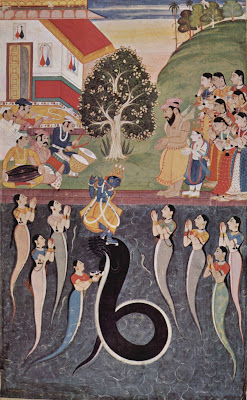A Las Vegas teen is recovering after being attacked by her 15-foot, 40-pound Burmese python.
- More about Reptiles and Amphibians
- September 4, 2008: Florida Wildlife Crowded by Swelling Human Population
- August 23, 2008: Alligator Seized From NoHo Home
- June 24, 2008: Fla. Teen Loses Arm To 11-Foot Gator
- June 17, 2008: Police Called In To Collar 7-Foot Gator In Fla.
Protection from Snakes (Paritta*)
Ven. Piyadassi
Thus have I heard: On one occasion the Blessed One was living near Savatthi at Jetavana at Anathapindika's monastery. At that time at Savatthi a certain monk had died of a snakebite.
Thereupon many recluses (bhikkhus) approached the Buddha and having saluted him sat beside him. So seated those recluses spoke thus to the Blessed One:
"Venerable Sir (Bhante), a certain recluse at Savatthi has died bitten by a snake."
"Assuredly, recluses," said the Buddha, "that monk did not suffuse with thoughts of loving-kindness (metta) the Four Royal Tribes of Snakes. Had he done so, that monk would not have died of snakebite.
"What are the Four Royal Tribes of Snakes? The royal tribe of snakes called Virupakkha, Erapatha, Chabyaputta, and Kanhagotamaka.
"Recluses, that monk, did not suffuse with thoughts of loving-kindness these four royal tribes of snakes. Had he done so, he would not have died of snakebite. Recluses, I enjoin you to suffuse with [unbounded] thoughts of loving-kindness these four royal tribes of snakes for your safety, for your preservation, and for your protection."
So said the Blessed One. Having thus spoken, the Buddha, the "Welcome One" (Sugata), further said (suggesting how they should express themselves):
1. May I have metta towards Virupakkhas
Towards Erapathas may I have metta
May my metta be towards Chabyaputtas
Towards Kanhagotamakas also metta may I have.
2. May I have mietta towards the footless
And towards bipeds too, my metta may I have
May I have metta towards the quadrupeds
And towards the many-footed also, metta may I have.
3. Let not the footless do me harm
Nor those that have two feet
Let not quadrupeds do me harm
Nor those endowed with many feet.
4. All beings, all living creatures,
May good fortune befall them all
May not the least harm on them befall.
"Unbounded (in virtue) is the Buddha, unbounded is the Dharma, unbounded is the Sangha. Finite are creeping creatures — snakes, scorpions, centipedes, spiders, lizards, and rats. I have guarded myself, I have made my protection. Depart from me, ye beings. I pay homage to the Blessed One and to the seven Supreme Buddhas" (Vipassi, Sikhi, Vessabhu, Kakusanda, Konagama, Kassapa, and Gautama).
*Khandha Paritta: Culla Vagga, ii. p. 110; also in the Anguttara under the title Ahi (metta) Sutra, ii.72; Khandha-Vatta Jataka, 203.
 Ancient Reptilians in art (click to enlarge, Wikipedia)
Ancient Reptilians in art (click to enlarge, Wikipedia)
Prehistoric Nāgas
Legends abound from Cambodia to Israel, from Norway to Laos, and exist among the tribal Hindus of Southern India (Adivasis) and the aboriginals of Australia. Nāgas are said to have inhabited a massive continent that existed somewhere in the Pacific Ocean. The warrior or kshatriya community of Kerala Nairs, who are believed to be descendants of Nagas (bloodline), have a small forest grove dedicated to Nagas (Wikipedia).


































































































































































































































No comments:
Post a Comment